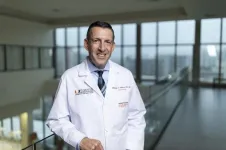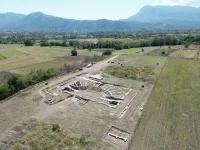(Press-News.org) DOWNLOADABLE VIDEO IS AVAILABLE HERE
MIAMI, FLORIDA (EMBARGOED UNTIL MONDAY, DEC. 11, 2023, AT 8:45 PM ET) – CAR-T cell therapy is a safe and effective treatment for diffuse large B-cell lymphoma (DLBCL), even for patients regarded as high risk due to comorbidities.
That’s the conclusion of a five-year analysis of results from the U.S. Lymphoma CAR-T Cell Consortium, a group of 17 academic cancer centers in the U.S. Their findings will be presented at the American Society of Hematology’s 2023 annual meeting in San Diego, Dec. 9-12.
“CAR-T has caused a paradigm shift in the treatment of patients with diffuse large B-cell lymphoma,” said Jay Y. Spiegel, MD, hematologist-oncologist at Sylvester Comprehensive Cancer Center at the University of Miami Miller School of Medicine and the study’s lead presenter at ASH. “Our findings support the vast potential of this therapy, even for high-risk patients, but highlight the need to maximize survivorship to ensure patients don’t end up dying from other causes.”
The consortium’s retrospective analysis featuring data from the group of top-tier cancer centers looked at five-year outcomes for DLBCL patients receiving CAR-T cell therapy, including those who would not have met eligibility criteria for the ZUMA-1 clinical trial.
Their assessment, which included 298 patients who underwent leukapheresis as part of the CAR-T cell process, also examined risk factors associated with worse survival outcomes, as well as longer-term toxicities and causes of non-relapse mortality.
FINDINGS
The analysis showed similar results to the ZUMA study with median follow-up of 58 months, despite including high-risk lymphoma patients who were ineligible for that study due to comorbidities -- the presence of other medical problems or decreased functional status.
Progression-free survival and overall survival rates at five years were comparable: 28.5% and 40.3%, respectively. Non-relapse deaths were primarily due to infection or secondary cancers, Spiegel noted.
“We were very encouraged by the results,” said Spiegel, a cellular therapy specialist at Sylvester, which was the seventh-largest data contributor to the study. “Often, results from clinical trials don’t translate to the larger population. But we were sobered by the rates of non-relapse mortality and that is where we need to improve.”
BACKGROUND
Diffuse large B-cell lymphoma, a fast-growing blood cancer, is the most common form of non-Hodgkin lymphoma. It occurs when genetic changes – mutations – turn healthy cells into cancerous ones and it often affects the lymphatic system.
According to the National Cancer Institute, DLBCL was diagnosed in six of every 100,000 people in 2020, while about 500 in every 100,000 were diagnosed with cancer affecting any part of their bodies.
Frontline therapy for DLBCL includes the monoclonal antibody drug rituximab, three chemotherapy drugs and a drug that helps kill lymphoma cells. This therapy is safe and effective, but does not always work or keep the cancer from returning. Some studies show DLBCL relapses or recurs in approximately 40% of patients receiving the standard therapy.
Depending on the length of time since completing frontline therapy, that’s when clinicians may turn to CAR-T cell therapy, a type of immunotherapy that genetically reengineers patients’ T cells to help their immune system find and kill the cancerous cells.
With this analysis, physicians – and patients – can be assured that CAR-T cell can impart durable remissions (and hopefully cures) for patients who fail chemotherapy or their lymphoma relapses or recurs, Spiegel said.
He added that CAR-T cell therapy has revolutionized the treatment paradigm for these lymphoma patients, who previously had few options after failure of standard chemotherapy.
“Before CAR-T, we were looking for anything to help put a patient’s disease in remission if they failed chemotherapy,” he explained. “Now, we’re focusing on survivorship outcomes and how we maximize the amount of people we’re curing and get them to live longer and better.”
Follow @SylvesterCancer on X for the latest news on Sylvester’s research and care.
Spiegel and collaborators will present their study at ASH on Monday, Dec. 11, at 8:45 P.M. EST (5:45 P.M. PST). Funding and disclosures are available in the abstract.
# # #
DOWNLOADABLE VIDEO IS AVAILABLE HERE
A high-resolution photo is available upon request.
END
(Santa Barbara, Calif.) — It’s official: The ketogenic diet proved to be effective at controlling polycystic kidney disease (PKD) in the first randomized controlled clinical trial of ketogenic metabolic therapy for PKD.
“I’m really happy about these clinical trial results,” said UC Santa Barbara biologist Thomas Weimbs, whose lab was part of an international collaboration to investigate the effect of the fasting response known as ketosis on the cysts that are the hallmark of the disease. “We now have the first evidence in humans that the cysts really don’t like ...
SAN DIEGO – Non-Hispanic Black patients with acute myeloid leukemia (AML) are living longer, now that new therapies are available, according to a study presented by researchers from the University of Pennsylvania Perelman School of Medicine and Penn Medicine’s Abramson Cancer Center at the 65th American Society of Hematology (ASH) Annual Meeting and Exposition (Abstract 955).
In the past, the standard treatment for AML, a cancer that affects the blood and bone marrow, was intensive chemotherapy. Unfortunately, many older patients were ineligible ...
Ukraine may have lost about 20% of its scientific research capacity — time directly spent by scientists on research activities — as a consequence of the Russia-Ukraine war. The findings, published in Humanities & Social Sciences Communications, also suggest that over 17% of scientists who were research active in Ukraine before the war may have left the scientific research sector by December 2022.
Since the full-scale Russian invasion of Ukraine began in February 2022, there has been disruption to many sectors of the Ukrainian economy, including the Ukrainian scientific research sector. However, it has so far proved difficult to quantify many of the key impacts of the ...
Until the early morning of February 24th, 2022, Ukrainian scientist Olena Iarmosh did not believe there would be a Russian invasion of Ukraine. Iarmosh grew up and had settled in Kharkiv, her beloved city in Eastern Ukraine and only 40 km away from the Russian border, where she worked for more than 16 years as a lecturer in higher education before fleeing to Switzerland. At approximately 5AM, she awoke to the sounds of bombing, hoping that they were merely the loud sounds of technical maintenance at the local power plant.
“My city looks worse now after the bombing than after two occupations by German troops,” ...
A striking and extremely rare half female, half male bird has been spotted by a University of Otago zoologist.
Sesquicentennial Distinguished Professor Hamish Spencer was holidaying in Colombia when an amateur ornithologist John Murillo pointed out a wild Green Honeycreeper with distinct half green, or female, and half blue, male, plumage.
“Many birdwatchers could go their whole lives and not see a bilateral gynandromorph in any species of bird. The phenomenon is extremely rare in birds, I know of no examples from New Zealand ever.
“It is very striking, I was very privileged to see it,” Professor Spencer says.
Photographs of the bird make ...
URBANA, Ill. – Nutrient runoff from agricultural production is a significant source of water pollution in the U.S., and climate change that produces extreme weather events is likely to exacerbate the problem. A new study from the University of Illinois Urbana-Champaign looks at how extreme rainfall impacts runoff and suggests possible mitigation strategies.
“We look at more than a decade of precipitation events in the state of Wisconsin and quantify the increase in nutrient runoff right around the event and at the end of the growing season. Climate ...
Peer-reviewed / Observational study / People
The Lancet Oncology: Risk of dying from cancer in some poorer districts of England over 70% higher than wealthy districts, study suggests
Analysis of the risk of dying from the most cancers with the largest death toll across the 314 districts in England finds that in 2019 the highest risks were in northern cities such as Liverpool, Manchester, Hull and Newcastle, and in coastal areas to the east of London.
The risk of dying from cancer before 80 years of age ranged from one in ten in Westminster to one in six in Manchester for women, and from one in eight in Harrow to one in five in Manchester ...
A spacecraft the size of a cereal box has collected precise measurements of the atmospheres of large and puffy planets called “hot Jupiters.” The findings, led by a team from the University of Colorado Boulder, could help reveal how the atmospheres around these and a host of other worlds are escaping into space.
The observations are the first results to come from a hard-working NASA spacecraft known as the Colorado Ultraviolet Transit Experiment (CUTE).
Kevin France, principal investigator for the mission, will present the group’s results at a media availability Monday, Dec. 11 at 4:30 p.m. at the 2023 meeting of the American ...
DOWNLOADABLE VIDEO
MIAMI, FLORIDA (EMBARGOED UNTIL MONDAY, DEC. 11, 2023 @ 7 P.M. ET) – In a study led by researchers at Sylvester Comprehensive Cancer Center at the University of Miami Miller School of Medicine, patients recently diagnosed with a common and aggressive form of acute myeloid leukemia reported having improved quality of life when a newly approved drug was part of the treatment plan.
Study results will be released during an oral presentation at the 65th ASH Annual Meeting and Exposition, the American Society of Hematology’s conference taking place in San Diego, California, Dec. 9-12. The ...
UNDER STRICT EMBARGO UNTIL 00:01 AM (UK TIME) ON TUESDAY 12TH DECEMBER 2023
A rare roofed theatre, markets, warehouses, a river port and other startling discoveries made by a Cambridge-led team of archaeologists challenge major assumptions about the decline of Roman Italy.
New findings from Interamna Lirenas, traditionally written off as a failed backwater in Central Italy, change our understanding of Roman history, its excavators believe.
Their thirteen-year study – published today in the edited volume Roman Urbanism in Italy ...






